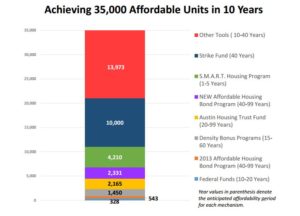First-of-its-kind housing plan presented to Planning Commission
Tuesday, October 25, 2016 by
Joseph Caterine In a city where 200,000 additional housing units will be needed over the next 30 years to meet the growing number of newcomers, having a plan to keep those units affordable is prudent. Accordingly, Jonathan Tomko, a senior planner with the city of Austin, presented a draft version of the Austin Strategic Housing Plan, the first of its kind, at the Oct. 11 Planning Commission meeting.
The plan was conceptualized last fall by city staff, and the draft has already been shared with City Council’s Housing and Community Development Committee. The plan’s stated goals are to coordinate resources and unify the direction of various departments in an effort to reach the thousands of Austinites suffering from rising rent prices and property taxes.
During his presentation, Tomko emphasized the urgency of closing the affordable rental housing gap, citing the 2014 Comprehensive Housing Market Analysis, a study commissioned by the city, which calculated that there were 48,000 households making less than 30 percent of the median family income who could not find anywhere to live. “The cost of closing that gap today with the subsidy levels we traditionally have seen would be about $6.48 billion,” he said to the commission. “If we were to wait and do nothing, that gap would grow, leading to about an $11.18 billion gap by 2025.”
The plan suggests setting future affordable housing goals by ZIP code, although Tomko told the Austin Monitor that Council districts are now being considered as a possible alternative.
Under that approach, each district would have the goal of maintaining at least 10 percent affordable rental units for households making less than 30 percent MFI and 25 percent affordable ownership units for households below 120 percent MFI.
As for how the city could help make that happen, Tomko shared a graph illustrating the different tools at the city’s disposal, including the Strike Fund, the density bonus programs and the SMART (safe, mixed-income, accessible, reasonably priced and transit-oriented) Housing Program.
After the presentation, Commissioner James Shieh asked what developers thought of the plan. Tomko responded that they were surveyed as part of the stakeholder outreach efforts and that their concerns echoed those brought up in the controversial 2015 Zucker Report.
Shieh reiterated that developers must be kept in the conversation around this plan, because the concerns they had in 2015 might be very different than their concerns now. “My biggest concern is that we would basically be putting out a plan that doesn’t work,” he said.

Commissioner Nuria Zaragoza asked to return to the presentation slide with the breakdown of the tools to be used to achieve 35,000 affordable units in 10 years. She proceeded to go through each tool’s actual potential. About 14,000 units are to be created using new tools from the housing plan, she said, which is still being drafted; 10,000 are to come from the Strike Fund that is currently not operational; and 2,331 are to come from the Affordable Housing Bond Program, which has not been passed yet. “If we keep doing what we are doing, the numbers are minuscule,” she said.
Zaragoza went on to say that the plan’s main strategy – in line with the CodeNEXT prescription papers – of increasing density along transit corridors puts already existing affordable housing in danger. “My biggest frustration with this paper is that we could potentially be jeopardizing our biggest source of affordable housing through redeveloping corridors,” she said.
At the end of the meeting, Zaragoza sponsored an item for the next meeting’s agenda to create a working group to study the housing plan more in depth in order to prepare for the final draft presentation in November. Commissioner Trinity White seconded.
Photo by Jonathan Billinger and licensed for reuse under this Creative Commons license. Graph from city of Austin.
The Austin Monitor’s work is made possible by donations from the community. Though our reporting covers donors from time to time, we are careful to keep business and editorial efforts separate while maintaining transparency. A complete list of donors is available here, and our code of ethics is explained here.
You're a community leader
And we’re honored you look to us for serious, in-depth news. You know a strong community needs local and dedicated watchdog reporting. We’re here for you and that won’t change. Now will you take the powerful next step and support our nonprofit news organization?










